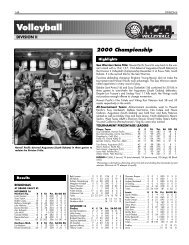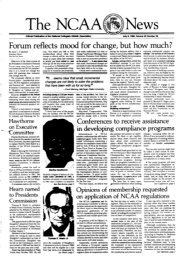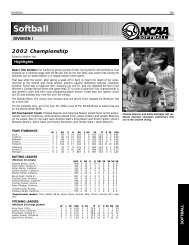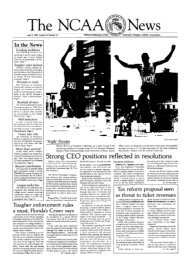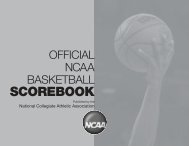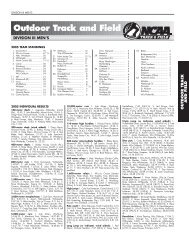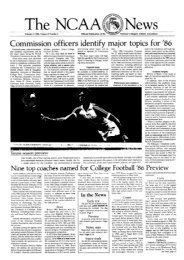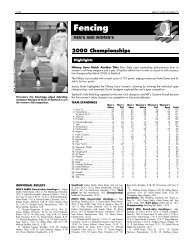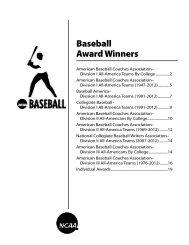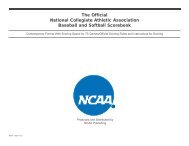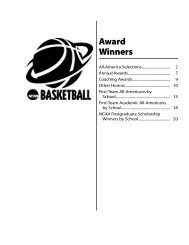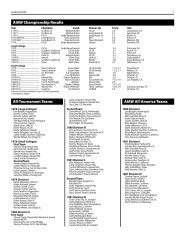Sports Medicine Handbook - NCAA
Sports Medicine Handbook - NCAA
Sports Medicine Handbook - NCAA
Create successful ePaper yourself
Turn your PDF publications into a flip-book with our unique Google optimized e-Paper software.
isk. Inadequate energy intakes<br />
increase fatigue, deplete muscle<br />
glycogen stores, increase the risk of<br />
dehydration, decrease immune<br />
function, increase the risk of injury<br />
and result in unwanted loss of<br />
muscle mass. A low caloric intake<br />
in female student-athletes can lead<br />
to menstrual dysfunction and<br />
decreased bone mineral density.<br />
The maintenance or attainment of<br />
an ideal body weight is sportspecific<br />
and represents an<br />
important part of a nutritional<br />
program. However, student-athletes<br />
in certain sports face a difficult<br />
paradox in their training/nutrition<br />
regimen, particularly those<br />
competing in “weight class” sports<br />
(e.g., wrestling, rowing), sports that<br />
favor those with lower body weight<br />
(e.g., distance running,<br />
gymnastics), sports requiring<br />
student-athletes to wear body<br />
contour-revealing clothing (track,<br />
diving, swimming, volleyball) and<br />
sports with subjective judging<br />
related to “aesthetics” (gymnastics,<br />
diving). These student-athletes are<br />
encouraged to eat to provide the<br />
necessary fuel for performance, yet<br />
they often face self- or teamimposed<br />
weight restrictions.<br />
Emphasis on low body weight or<br />
low body fat may benefit<br />
performance only if the guidelines<br />
are realistic, the calorie intake is<br />
reasonable and the diet is<br />
nutritionally well-balanced.<br />
The use of extreme weight-control<br />
measures can jeopardize the health<br />
of the student-athlete and possibly<br />
trigger behaviors associated with<br />
eating disorders. <strong>NCAA</strong> studies<br />
have shown that at least 40 percent<br />
of member institutions reported at<br />
least one case of anorexia nervosa<br />
or bulimia nervosa in their athletics<br />
programs. Once identified, these<br />
individuals should be referred for<br />
medical evaluation and<br />
psychological and nutritional<br />
therapy.<br />
A more prevalent issue is the large<br />
number of sub-clinical or<br />
chronically dieting athletes.<br />
Department-wide efforts to educate<br />
staff and student-athletes should<br />
include addressing the negative<br />
impacts of under-fueling and<br />
weight/food preoccupation on the<br />
athletes’ performance and overall<br />
well-being. Although dysfunctional<br />
eating is much more prevalent in<br />
women (approximately 90 percent<br />
of the reports in the <strong>NCAA</strong> studies<br />
were in women’s sports),<br />
dysfunctional eating also occurs in<br />
men. Female athletes who miss<br />
three or more menstrual cycles in a<br />
year, are preoccupied with weight,<br />
experience rapid changes in body<br />
weight, avoid eating with others, or<br />
are over-focused on shape and food<br />
are exhibiting warning signs worth<br />
addressing, if prevention of eating<br />
disorders is desired. The medical<br />
examination and updated history<br />
(Bylaw 17.1.5) is an opportunity to<br />
assess athletes for these risk factors<br />
and refer them to appropriate<br />
professionals for further evaluation<br />
and diagnosis.<br />
Eating disorders are often an<br />
expression of underlying emotional<br />
distress that may have developed<br />
long before the individual was<br />
involved in athletics. Eating<br />
disorders can be triggered in<br />
psychologically vulnerable<br />
individuals by a single event or<br />
comments (such as offhand remarks<br />
about appearance, or constant<br />
badgering about a student-athlete’s<br />
body weight, body composition or<br />
body type) from a person important<br />
to the individual. Coaches, athletic<br />
trainers, sport dietitians and<br />
supervising physicians must be<br />
watchful for student-athletes at<br />
higher risk for eating disorders.<br />
Disordered eating can lead to<br />
Nutrition and Athletic Performance<br />
Eating disorders are<br />
often an expression of<br />
underlying emotional<br />
distress that may have<br />
developed long before<br />
the individual was<br />
involved in athletics.<br />
Eating disorders can be<br />
triggered in<br />
psychologically<br />
vulnerable individuals<br />
by a single event or<br />
comments (such as<br />
offhand remarks about<br />
appearance, or<br />
constant badgering<br />
about a studentathlete’s<br />
body weight,<br />
body composition or<br />
body type) from a<br />
person important to<br />
the individual.<br />
45



